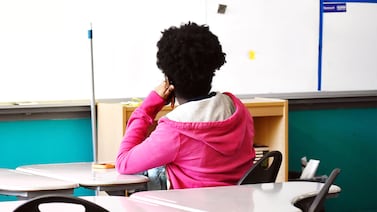Sign up for Chalkbeat Indiana’s free daily newsletter to keep up with Indianapolis Public Schools, Marion County’s township districts, and statewide education news.
Student proficiency on the state’s elementary reading test rose slightly in 2024, the last year before schools must hold back third graders under Indiana’s revised retention law if they don’t pass the test or meet a few exemptions.
This year, 82.5% of third graders passed the IREAD-3 compared with just under 82% of third graders in 2023. It’s the largest single-year increase since IREAD started in 2013, according to the Indiana Department of Education.
The department said the scores prove that Indiana’s push for literacy instruction backed by the science of reading, a large body of research on how kids learn to read that emphasizes explicit phonics instruction, is getting results. But this year’s scores still do not match the pre-pandemic proficiency rate — in 2019, 87.3% of third graders passed the test.
“The pandemic only helped to highlight the critical need for literacy support,” Lynn Schemel, the department’s chief academic officer, said Wednesday at the State Board of Education Meeting. “Since the pandemic, our scores have continued to increase.”
Under the science of reading mandate, school districts and charter schools have adopted new curriculums. Schools also had the option of joining the Indiana Literacy Cadre to receive professional development aligned with the new state standards. And preparation programs for Indiana teacher candidates have started emphasizing science of reading concepts.
This year, IREAD scores at schools that opted into the literacy cadre rose by 2.5 percentage points on average, compared with an increase of 0.2 percentage points on average at schools that did not join the cadre, according to the department.
“What we’re looking at right here is an outstanding thing,” Indiana Secretary of Education Katie Jenner said. “It’s unbelievably exciting because [the literacy cadre] moved the needle significantly more.”
The mandate for schools to use instruction that relied on the science of reading was signed into law last year by Gov. Eric Holcomb. In 2022, Holcomb set a goal that 95% of third graders would achieve proficiency on the state’s elementary reading exam by 2027.
Next year, if third graders don’t pass and don’t qualify for a “good cause exemption,” such as having a disability or being an English learner, they will not be able to move on to the next grade under the retention law enacted this year.
Before the law, state data showed that thousands of third graders who were not reading proficiently and did not meet exemption criteria were “socially promoted” to fourth grade. Last year, nearly three-quarters of the students who didn’t pass the IREAD-3 came from low-income households.
In 2022, the state let schools administer the test to second graders to identify students in need of additional literacy instruction. The department said early intervention for second graders not reading proficiently in 2023 has been critical in the gains seen this year.
“What an opportunity we have to turn that corner even more and get a higher percentage of students who are at-risk, passing,” Jenner said.
Black students’ IREAD scores show notable increase
Although student improvement on the IREAD has been sluggish at best in the last several years, some groups are registering notable gains compared to the state’s overall performance.
This year, 68.6% of Black students passed the IREAD. That’s an increase of 3.2 percentage points from last year and a 6.6 percentage-point increase since 2021. Students with disabilities and students receiving free or reduced-price meals also improved, with gains of 2.2 percentage points and 1.8 percentage points, respectively.
White and Asian students had proficiency rates of 88.3% and 86.3%, both marginal increases from last year’s exam.
Not every student group’s scores increased from last year, however. Scores for Hispanic students and English learners decreased by 0.3 and 0.4 percentage points, respectively. In 2024, 68.6% of Hispanic students passed the exam, while 63.6% of English learners passed.
“That’s an area that we’ve called out multiple times, but we have to continue to focus on our English language learners and our Hispanic students,” Jenner said. “Just so the board knows, at the Department of Education, we’re going to take a deeper dive into that as well.”
Haley Miller is a summer reporting intern covering education in the Indianapolis area. Contact Haley at hmiller@chalkbeat.org.







